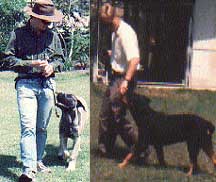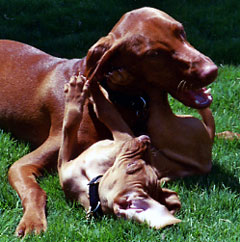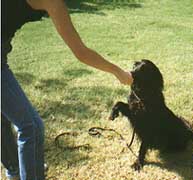Mixed and Balanced Dog training – the Middle Way
What is Balanced Dog Training? It’s the Middle Way, mixing traditional training and positive reinforcement. Learn more about how a mixed (whole) training style can help you and your dog by exploring the pages on OC Dog Training – By Andrew Ledford 714-827-4058
Whole dog training the middle way.
The articles on this site will help you recognize which styles of dog training will work best for you and the canine companion(s) you care for. Some people call this style of training, mixed dog training or balanced dog training.
I advocate using a whole owner / pet educational system.

Whole dog training involves reward training, physical placement and control of your pet, negative feedback, as well as social relationship conditioning, including sensitivity exercise. It balances the dynamic harmony found in a pet owning household.
Balanced dog training uses both traditional leash and collar training combined with food reinforcement or other forms of positive reinforcement.

Whole or balanced dog training starts with the pet’s natural characteristics and physical state (genetic history, basic needs, individual temperament, health, etc.…).
Vizslas in a balanced training program
The next consideration is your pet’s social environment and social skills.
Teaching techniques and their application are the third aspect of a complete pet education program.
Teaching techniques can be either hard or soft. What’s important is to blend all aspects of the dog’s development into a harmonious whole. Often the actual technique is not as important as how the technique is used. A complete owner/dog education program contains both soft and hard techniques.
How you blend and balance these three elements can make the difference between an ill-mannered or well-mannered pet.
It is my belief that most pet dogs should have some type of leash work, either traditional leash and collar work, or conditioning with one of the newer head collars.

Next I strongly advocate the use of reinforcement based teaching systems.
Reinforcement Training in a Comprehensive Whole Dog training Program
Social relationship conditioning is built around sensitivity exercises.
The third aspect of a whole balanced dog training program is a type of conditioning based primarily in the social relationship between the owners and the pet. The first two parts of the dog training process are the tools most people need to reach or come closer to the third. When beginning a training program I feel that leash work and reinforcement work should be taught separately and that Social Relationship work be incorporated into all canine development programs from the start.
Our programs are primarily directed toward educating household pets and their owners. Owner/pet education programs are designed to teach basic obedience, life skills, house manners, how to prevent future behavior problems from developing, and how to solve existing behavior problems. We can loosely term this hazard avoidance training. This term is used because these drills are meant to teach the dog how to avoid behavior that is either hazardous to the dog or to people.
I am a dog training moderate.
To leash and collar force trainers I’m a food training softy. To reinforcement trainers I’m an abusive force trainer. I think I heard one call me “unethical” because I don’t adhere to her extremist views
What I am not is a method training extremist. The two most common extremist camps are the reinforcement extremist and the force extremists.
The reinforcement extremists usually think it’s better to destroy a dog rather than use a training collar. Yet at the same time, reinforcement extremists seem to come across as wanting to treat dogs more humanly than humans.
The most common reinforcement extremist methods are:
- 100% clicker training. I do use clickers in my training and I have since the early 80’s. This type of training is very effective, but it does have some limitations.
- Training methods where food or toys are the primary reinforcers used and traditional training collars are never to be used. Hard core force trainers sometimes think I’m one of these food training “cookie people.”
The force extremist usually think, if you can’t forcibly correct the dog into good behavior there is no training the dog. Generally, force extremists don’t understand how operant conditioning and reinforcement training works to change behavior.
Some common force extremist methods are:
- European dog training. Especially associated with protection dog training. I have met many very good trainers from Europe that successfully train armies of dogs using this method, However it is not always the best way to train that canine specialist we call a pet.
- The Koehler Method of dog training. Koehler was an exceptionally good dog trainer. I trained a dog under Koehler when I was in high school and this experience was very educational for me. However from reading his books and looking back on my time in his training class, I don’t think he was aware of how reinforcement training really worked.

There are many styles of teaching that will work for many pets. Although there are large numbers of dogs that can be taught with any of the many styles, there are also many (even if fewer) pets that need to be taught with an approach that’s right for that particular pet. In this case, an inappropriate teaching style can lead to disaster.
Puppy training can start at 7 weeks with an in-home puppy training program. Although pet dogs are now my main focus I have a background in protection dogs, security k-9s, and police dogs. I have also helped design therapy dog programs that help people who are in treatment for physical and mental illnesses.
We will soon add new programs that go beyond basic pet behavior. I am looking for a location for holding trick dog and movie dog training classes
Start enjoying the benefits of a great relationship with your special pet….
Call me – Andrew Ledford today at
714-827-4058
